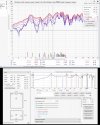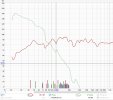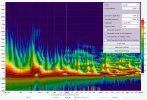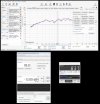I was just reviewing my own speaker measurements, for my right speaker in particular, which happens to sit next to a window recess. I saw strange areas on the Decay plot that didn't align with room modes, like the 0/20/40ms slices being lower SPL than the 60+ms slices. So I picked one to investigate: 120Hz. Here is the decay plot with Room Sim;

The SPL&Phase plot and the spectrogram don't reveal the full extent of the issue;


But I exported the IR and convolved it with a 1 cycle tone, and a long tone (~0.5sec), and wow, massive issue detected! The long tone reveals it is being cancelled over time, whereas ideally the SPL should be continuous.

But the REW SPL number shows that the SPL is quite comparable to other areas of non-peaking SPL. So I ran some new sweeps with differing lengths in REW, to see if that made a difference. It didn't. So then I used "Generator" and "SPL meter" to record the SPL of a continuous 120Hz tone;

A dismal 67dB, when REW suggests it should be nearly 81dB. That's a 14dB difference. And just to prove I was measuring correctly, I tested another frequency that looked "normal", and the results were normal (near the correct volume). So this isn't a "testing error";

I went back to Audacity to check what the long-term SPL was reported as, and it's ~16dB lower, so pretty close to the ~14dB difference I just measured.

Next I wondered what is causing this issue. I foreshadowed the issue at the start of the post when I mentioned the window recess (it's a double brick wall). But first I did 343/120/4 to get the relevant 1/4 cycle wave length of 120Hz, which is 715mm. And guess how far the one of the window's edges is away from the speaker: ~715mm. And so I measured to the opposite edge, which is ~450mm = 190Hz = a strange area on the decay plot. And the top edge (the lintel) is ~1.1m and shows up on the decay plot as the 78Hz issue.

(BTW, I took the above measures with the blind up (the blind is "in" the recess), but took a photo with it down to block some sunlight for the photo - not that I think the blind will do anything at these frequencies.)
So that's all I've discovered today. I had noticed the "in room" SPL discrepancy of a 1 cycle vs many cycle tone in the course of the VBA thread we have going (here's a recent post mentioning it), but it was only "simulations". Here in this thread I have shown it in affect in my room. I haven't tried any sort of VBA method to "cancel the cancel" yet.
Actually I think it would be better to just "fix" this window properly. I would like to keep the light it provides though, so I wonder if it would sufficient to use a full sheet of glass or acrylic to make the internal surface flush? Or would I have to fill the "void"?
Lastly, I wonder about REW. I get that a REW sweep is based upon a short sample of each frequency (not sure if it's a dirac impulse or a 1 cycle tone or what exactly), and that the IR it captures/measures technically implies the affects I discovered above, but it doesn't actually show this on any SPL graph AFAIK. This post shows a problem causing less SPL over time, but room modes for example actually gain SPL over time (until the old waves become irrelevant, and the SPL becomes steady). Maybe there is a way to see this in REW that I am not aware of? Or maybe a graph needs adding to show this affect?

The SPL&Phase plot and the spectrogram don't reveal the full extent of the issue;


But I exported the IR and convolved it with a 1 cycle tone, and a long tone (~0.5sec), and wow, massive issue detected! The long tone reveals it is being cancelled over time, whereas ideally the SPL should be continuous.

But the REW SPL number shows that the SPL is quite comparable to other areas of non-peaking SPL. So I ran some new sweeps with differing lengths in REW, to see if that made a difference. It didn't. So then I used "Generator" and "SPL meter" to record the SPL of a continuous 120Hz tone;

A dismal 67dB, when REW suggests it should be nearly 81dB. That's a 14dB difference. And just to prove I was measuring correctly, I tested another frequency that looked "normal", and the results were normal (near the correct volume). So this isn't a "testing error";

I went back to Audacity to check what the long-term SPL was reported as, and it's ~16dB lower, so pretty close to the ~14dB difference I just measured.

Next I wondered what is causing this issue. I foreshadowed the issue at the start of the post when I mentioned the window recess (it's a double brick wall). But first I did 343/120/4 to get the relevant 1/4 cycle wave length of 120Hz, which is 715mm. And guess how far the one of the window's edges is away from the speaker: ~715mm. And so I measured to the opposite edge, which is ~450mm = 190Hz = a strange area on the decay plot. And the top edge (the lintel) is ~1.1m and shows up on the decay plot as the 78Hz issue.

(BTW, I took the above measures with the blind up (the blind is "in" the recess), but took a photo with it down to block some sunlight for the photo - not that I think the blind will do anything at these frequencies.)
So that's all I've discovered today. I had noticed the "in room" SPL discrepancy of a 1 cycle vs many cycle tone in the course of the VBA thread we have going (here's a recent post mentioning it), but it was only "simulations". Here in this thread I have shown it in affect in my room. I haven't tried any sort of VBA method to "cancel the cancel" yet.
Actually I think it would be better to just "fix" this window properly. I would like to keep the light it provides though, so I wonder if it would sufficient to use a full sheet of glass or acrylic to make the internal surface flush? Or would I have to fill the "void"?
Lastly, I wonder about REW. I get that a REW sweep is based upon a short sample of each frequency (not sure if it's a dirac impulse or a 1 cycle tone or what exactly), and that the IR it captures/measures technically implies the affects I discovered above, but it doesn't actually show this on any SPL graph AFAIK. This post shows a problem causing less SPL over time, but room modes for example actually gain SPL over time (until the old waves become irrelevant, and the SPL becomes steady). Maybe there is a way to see this in REW that I am not aware of? Or maybe a graph needs adding to show this affect?
Last edited:


